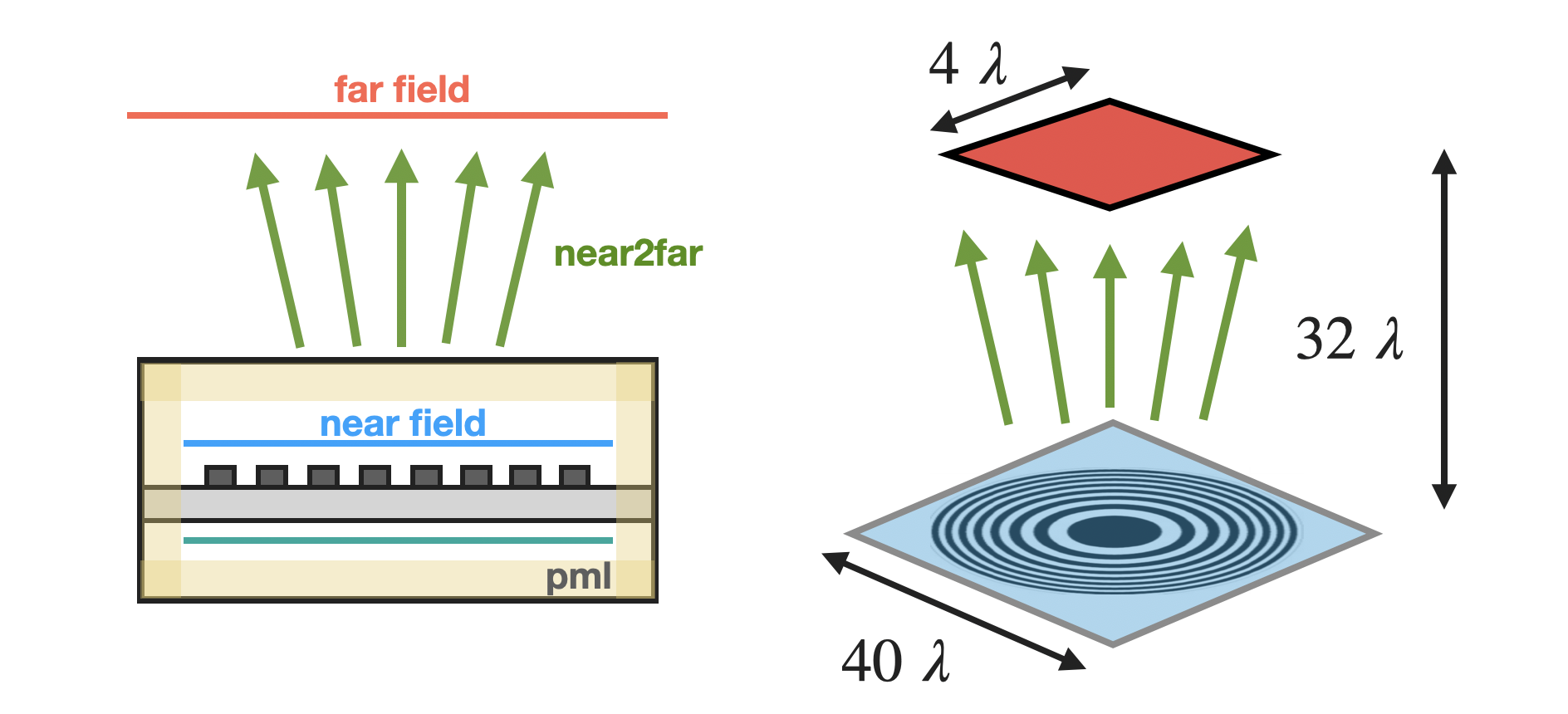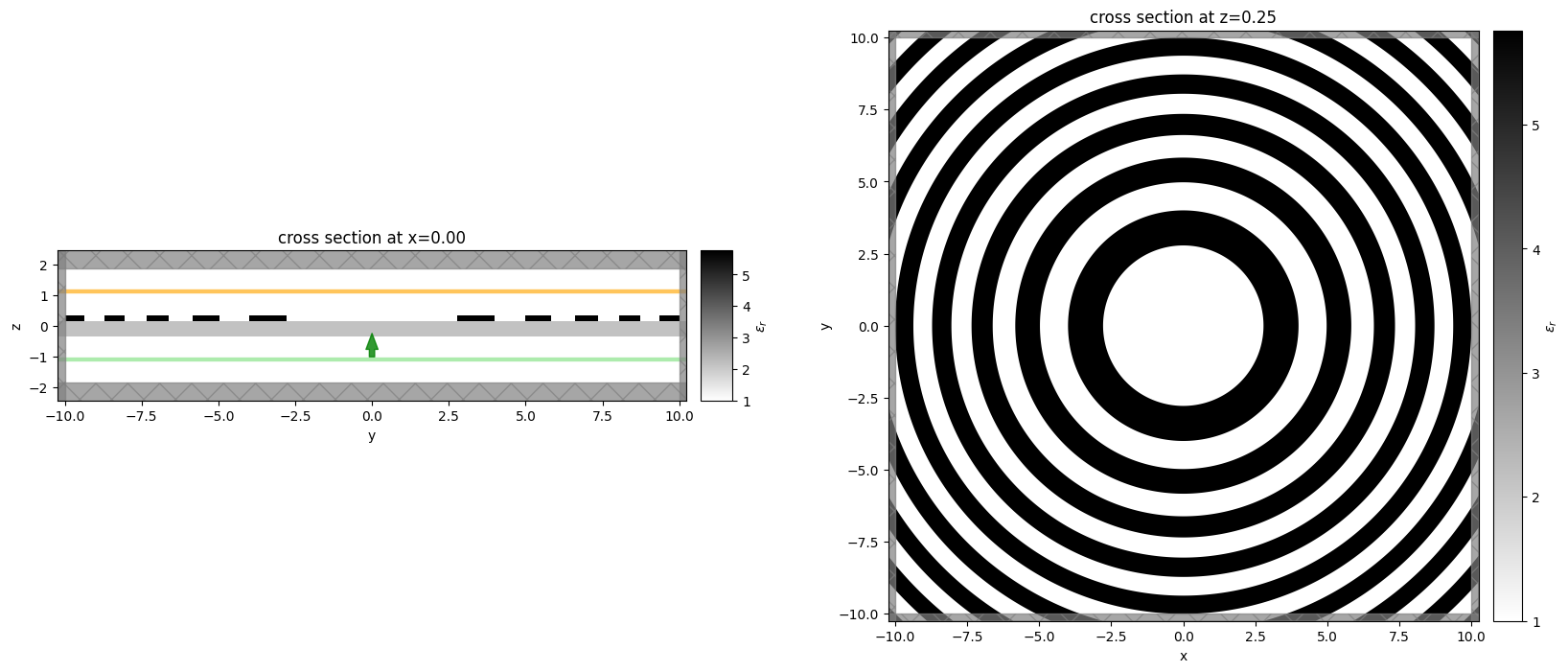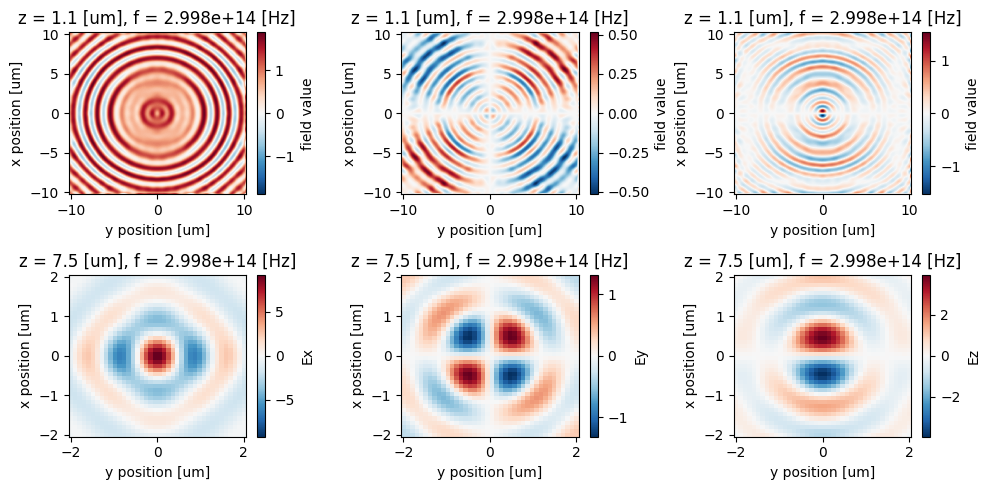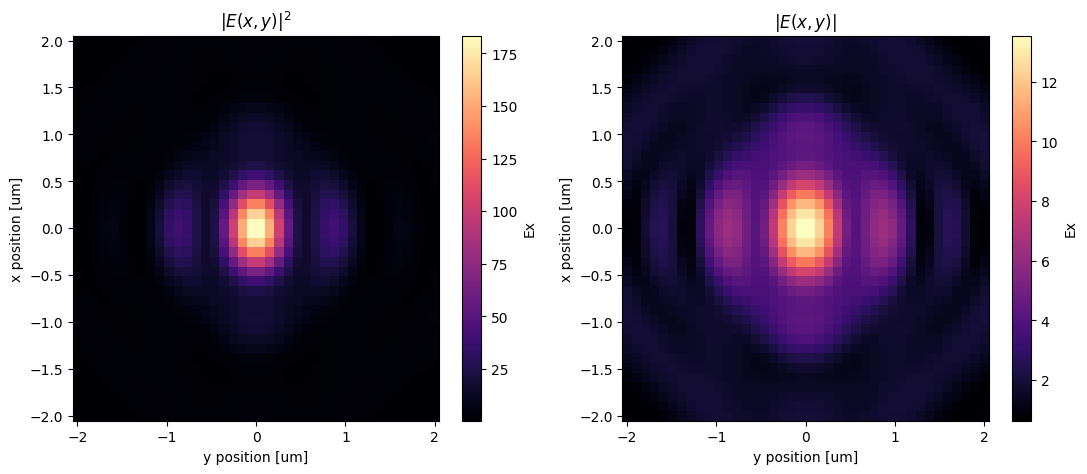Field projection for a zone plate
Contents
Field projection for a zone plate#
This tutorial will show you how to solve for electromagnetic fields far away from your structure using field information stored on a nearby surface.
This field projection technique is very useful for reducing the simulation size needed for structures involving lots of empty space.
As an example, we will simulate a simple zone plate lens with a very thin domain size, and measure the transmitted fields just above the structure. Then, we’ll show how to use field projections to compute the fields at the focal plane above the lens.
For more simulation examples, please visit our examples page. If you are new to the finite-difference time-domain (FDTD) method, we highly recommend going through our FDTD101 tutorials. FDTD simulations can diverge due to various reasons. If you run into any simulation divergence issues, please follow the steps outlined in our troubleshooting guide to resolve it.
[1]:
# standard python imports
import numpy as np
import matplotlib.pyplot as plt
# tidy3d imports
import tidy3d as td
import tidy3d.web as web
Problem Setup#
Below is a rough sketch of the setup of the field projection.
The transmitted near fields are measured just above the metalens on the blue line, and are projected to the focal plane denoted by the red line.

Define Simulation Parameters#
As always, we first need to define our simulation parameters. As a reminder, all length units in tidy3D are specified in microns.
[2]:
# 1 nanometer in units of microns (for conversion)
nm = 1e-3
# free space central wavelength
wavelength = 1.0
# numerical aperture
NA = 0.8
# height of lens features
height_lens = 200 * nm
# space between bottom PML and substrate (-z)
# and the space between lens structure and top pml (+z)
space_below_sub = 1.5 * wavelength
# height of substrate (um)
height_sub = wavelength / 2
# side length (xy plane) of entire metalens (um)
length_xy = 20 * wavelength
# Lens and substrate refractive index
n_TiO2 = 2.40
n_SiO2 = 1.46
# define material properties
air = td.Medium(permittivity=1.0)
SiO2 = td.Medium(permittivity=n_SiO2**2)
TiO2 = td.Medium(permittivity=n_TiO2**2)
Process Geometry#
Next we perform some conversions based on these parameters to define the simulation.
[3]:
# because the wavelength is in microns, use builtin td.C_0 (um/s) to get frequency in Hz
f0 = td.C_0 / wavelength
# Define PML layers, for this application we surround the whole structure in PML to isolate the fields
boundary_spec = td.BoundarySpec.all_sides(boundary=td.PML())
# domain size in z, note, we're just simulating a thin slice: (space -> substrate -> lens height -> space)
length_z = space_below_sub + height_sub + height_lens + space_below_sub
# construct simulation size array
sim_size = (length_xy, length_xy, length_z)
Create Geometry#
Now we create the ring metalens programatically
[4]:
# define substrate
substrate = td.Structure(
geometry=td.Box(
center=[0, 0, -length_z / 2 + space_below_sub + height_sub / 2.0],
size=[td.inf, td.inf, height_sub],
),
medium=SiO2,
)
# focal length
focal_length = length_xy / 2 / NA * np.sqrt(1 - NA**2)
# location from center for edge of the n-th inner ring, see https://en.wikipedia.org/wiki/Zone_plate
def edge(n):
return np.sqrt(n * wavelength * focal_length + n**2 * wavelength**2 / 4)
# loop through the ring indeces until it's too big and add each to geometry list
n = 1
r = edge(n)
rings = []
while r < 2 * length_xy:
# progressively wider cylinders, material alternating between air and TiO2
cylinder = td.Structure(
geometry=td.Cylinder(
center=[
0,
0,
-length_z / 2 + space_below_sub + height_sub + height_lens / 2,
],
axis=2,
radius=r,
length=height_lens,
),
medium=TiO2 if n % 2 == 0 else air,
)
rings.append(cylinder)
n += 1
r = edge(n)
# reverse geometry list so that inner, smaller rings are added last and therefore override larger rings.
rings.reverse()
geometry = [substrate] + rings
Create Source#
Create a plane wave incident from below the structure
[5]:
# Bandwidth in Hz
fwidth = f0 / 10.0
# Gaussian source offset; the source peak is at time t = offset/fwidth
offset = 4.0
# time dependence of source
gaussian = td.GaussianPulse(freq0=f0, fwidth=fwidth)
source = td.PlaneWave(
center=(0, 0, -length_z / 2 + space_below_sub / 2),
size=(td.inf, td.inf, 0),
source_time=gaussian,
direction="+",
pol_angle=0.0,
)
# Simulation run time
run_time = 40 / fwidth
Create Monitors#
We’ll create a FieldProjectionCartesianMonitor monitor which measures the fields just above the structure, and projects them to a Cartesian plane in the far field a given distance away. We’ll also make a dedicated near-field monitor just to see what the near fields look like.
[6]:
# place the monitors halfway between top of lens and PML
pos_monitor_z = (
-length_z / 2 + space_below_sub + height_sub + height_lens + space_below_sub / 2
)
# set the points on the observation grid at which fields should be projected
num_far = 40
xs_far = 4 * wavelength * np.linspace(-0.5, 0.5, num_far)
ys_far = 4 * wavelength * np.linspace(-0.5, 0.5, num_far)
monitor_far = td.FieldProjectionCartesianMonitor(
center=[
0.0,
0.0,
pos_monitor_z,
], # center of the near field surface on which fields are recorded
size=[
td.inf,
td.inf,
0,
], # size of the near field surface on which fields are recorded
normal_dir="+", # normal vector direction of the near field surface on which fields are recorded
freqs=[f0],
name="farfield",
x=xs_far,
y=ys_far,
proj_axis=2, # direction along which fields are projected
proj_distance=focal_length, # signed distance along the projection axis at which the observations grid resides
far_field_approx=False, # turn off the geometric far field approximations, which in this case would lead to
# inaccurate fields because the distance to the focal plane is of the same order as
# the size of the structure and the near field monitor
)
monitor_near = td.FieldMonitor(
center=[0.0, 0.0, pos_monitor_z],
size=[td.inf, td.inf, 0],
freqs=[f0],
name="nearfield",
)
[19:33:30] WARNING: Default value for the field monitor monitor.py:261 'colocate' setting has changed to 'True' in Tidy3D 2.4.0. All field components will be colocated to the grid boundaries. Set to 'False' to get the raw fields on the Yee grid instead.
Create Simulation#
Put everything together and define a simulation object. A nonuniform simulation grid is generated automatically based on a given number of cells per wavelength in each material (10 by default), using the frequencies defined in the sources.
[7]:
simulation = td.Simulation(
size=sim_size,
grid_spec=td.GridSpec.auto(min_steps_per_wvl=20),
structures=geometry,
sources=[source],
monitors=[monitor_far, monitor_near],
run_time=run_time,
boundary_spec=boundary_spec,
)
WARNING: Structure at structures[57] has bounds simulation.py:458 that extend exactly to simulation edges. This can cause unexpected behavior. If intending to extend the structure to infinity along one dimension, use td.inf as a size variable instead to make this explicit.
Note: Tidy3D warns us that one of the rings is touching the PML boundary. This warning is intended to prevent people from placing, for example, a substrate next to the PML without extending into it. In our case, the ring is not supposed to be extending into the PML so we can safely ignore the warning.
Visualize Geometry#
Let’s take a look and make sure everything is defined properly
[8]:
fig, (ax1, ax2) = plt.subplots(1, 2, figsize=(20, 8))
simulation.plot_eps(x=0, ax=ax1)
simulation.plot_eps(
z=-length_z / 2 + space_below_sub + height_sub + height_lens / 2, ax=ax2
)
plt.show()

Run Simulation#
Now we can run the simulation and download the results
[9]:
import tidy3d.web as web
sim_data = web.run(
simulation, task_name="zone_plate", path="data/simulation.hdf5", verbose=True
)
View task using web UI at webapi.py:190 'https://tidy3d.simulation.cloud/workbench?taskId=fdve- 9982a94e-0039-45c0-8d20-43ce2d6e32a4v1'.
WARNING: Structure at structures[57] has bounds simulation.py:458 that extend exactly to simulation edges. This can cause unexpected behavior. If intending to extend the structure to infinity along one dimension, use td.inf as a size variable instead to make this explicit.
Visualization#
[10]:
near_field_data = sim_data["nearfield"]
fig, (ax1, ax2, ax3) = plt.subplots(1, 3, tight_layout=True, figsize=(15, 3.5))
near_field_data.Ex.real.plot(ax=ax1)
near_field_data.Ey.real.plot(ax=ax2)
near_field_data.Ez.real.plot(ax=ax3)
plt.show()

Getting Far Field Data#
The FieldProjectionCartesianMonitor object ensures that the projected fields are already computed on the server during the simulation run.
The projected fields can then be used to quickly return various quantities such as power and radar cross section.
For this example, we use FieldProjectionCartesianData.fields_cartesian to get the fields at the previously-set x,y,z points as an xarray Dataset.
[11]:
projected_fields = sim_data[monitor_far.name].fields_cartesian
Plot Results#
Now we can plot the near and far fields together
[12]:
# plot everything
f, (axes_near, axes_far) = plt.subplots(2, 3, tight_layout=True, figsize=(10, 5))
def pmesh(xs, ys, array, ax, cmap):
im = ax.pcolormesh(xs, ys, array.T, cmap=cmap, shading="auto")
return im
ax1, ax2, ax3 = axes_near
im = near_field_data.Ex.real.plot(ax=ax1)
im = near_field_data.Ey.real.plot(ax=ax2)
im = near_field_data.Ez.real.plot(ax=ax3)
ax1, ax2, ax3 = axes_far
im = projected_fields["Ex"].real.plot(ax=ax1)
im = projected_fields["Ey"].real.plot(ax=ax2)
im = projected_fields["Ez"].real.plot(ax=ax3)
plt.show()

We can also use the far field data and plot the field intensity to see the focusing effect.
[13]:
intensity = 0
for field in ("Ex", "Ey", "Ez"):
intensity += np.abs(projected_fields[field].isel(z=0, f=0)) ** 2
_, (ax1, ax2) = plt.subplots(1, 2, figsize=(13, 5))
np.sqrt(intensity).plot(ax=ax2, cmap="magma")
intensity.plot(ax=ax1, cmap="magma")
ax1.set_title("$|E(x,y)|^2$")
ax2.set_title("$|E(x,y)|$")
plt.show()

[ ]: